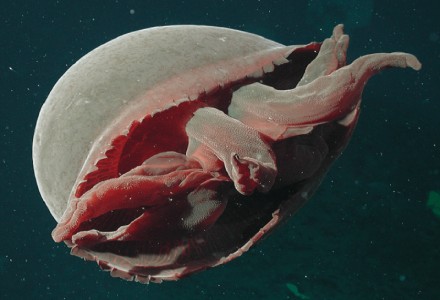
Tiburonia granrojo Facts
- Most notably, the completely astonishing Tiburonia granrojo stands out from related creatures for one remarkable reasons. That’s because it represents a newly discovered form of truly unique jellyfish. This incredible find also makes for a new genus, a remarkable discovery.
- However, this incredible find doesn’t simply represent a new species. In point of fact, the fascinating animal also represents an entirely previously unknown genus. The first recognition as a possible new discovery occurred in 1998, to the astonishment of many scientists.
- Furthermore, subsequent reviews of underwater films identified it as having been observed as early as 1993. However, it required extensive study and analysis before a final conclusion could be arrived at. As a result of this , the final confirmation of its status did not occur until 2010.
- Quite unfortunately, scientists know very little about the Tiburonia granrojo. That’s because, to date, a total of only 23 individuals have been sighted, and only one specimen has been captured for study. Due to the understandable lack of date, the IUCN currently has no listing for it.
Related Articles
Flower Hat Jellyfish Turritopsis Nutricula Fried Egg Jellyfish
Tiburonia granrojo Physical Description
Quite unfortunately, the lamentable lack of fully reliable data also extends to the physical characteristics of the Tiburonia granrojo. Since the number of specimens studied remains so low, some facts and principles remain uncertain. Among these is if those observed represent a statistically sufficient number to state traits with certainty.
Consequently, all physical measurements of the species, among other facts, may be subject to revision at a later date. For the moment, however, some deductions on the part of researchers exist. First of all, unlike related creatures, this astonishing animal does not possess long, slender tentacles. Instead it develops thick, fleshy arms.
In addition, the amazing Tiburonia granrojo also ranks among the largest of the known varieties of jellyfish. This holds true because, based on the few specimens seen, it appears to attain a diameter of up to 30 in (75 cm). Further, in color, the animal presents a deep red, in contrast to the virtually transparent nature of other jellyfish.
- Kingdom: Animalia
- Phylum: Cnidaria
- Class: Scyphozoa
- Order: Semaeostomeae
- Family: Ulmaridae
- Genus: Tiburonia
- Species: T. granrojo
Tiburonia granrojo Distribution, Habitat, and Ecology
Sadly, another of the things of which researchers remain uncertain about concerning the Tinburonia granrojo is its complete habitat range. That’s because, to date, its only known habitats include the Pacific Ocean, Sea of Cortez, Monterey Bay, and off the shores of Japan and Hawaii. For now, it’s far too soon to know if this forms the entirety of its range or not.
Additionally, yet again, scientists cannot state categorically the precise nature of its preferred habitat. But, since every observation of individuals to date occurred within a certain range, this seems likely to be its natural range. So far, all known specimens dwelt at depths of between 2,000 – 4,900 ft (600 – 1,500 m). This qualifies the incredible life form as a deep-dwelling species.
Furthermore, given the lack of detailed information, its precise diet also cannot be officially confirmed. Nonetheless, it seems reasonable to assume that its diet would be at least similar to other cnidarians. Therefore, the amazing Tiburonia granrojo most likely preys on a variety of small sea cretures. Finally, and sadly, no detailed data pertaining to its life cycle yet exists.
Species Sharing Its Range
Maui Dolphin Japanese Spider Crab Sea Spider
Check out our other articles on 5 Rare Mind-Blowing Cloud Types, Vietnamese Mossy Frog, Cerro Sarisarinama, Chatham Island forget-me-not, Draco Volans, Comet Moth

